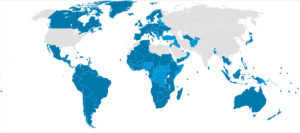GS2 – International Relations

Poland, Finland, and the Baltic nations (Lithuania, Latvia, Estonia) have announced intentions to exit the Ottawa Convention.
About
- Also known as the Mine Ban Treaty, it is an international disarmament agreement that prohibits the use, development, production, stockpiling, and transfer of anti-personnel landmines.
- The treaty was adopted in December 1997 and entered into force in March 1999.
Purpose:
The primary goal of the convention is to address the enduring humanitarian impact of landmines and support recovery efforts in conflict-affected areas.
Nature of Anti-personnel Mines:
- These mines are designed to explode on contact or close proximity, often hidden underground.
- According to the International Committee of the Red Cross, more than 80% of their victims are civilians, many of whom suffer from amputations and permanent injuries.
Key Provisions:
- Obligations under the treaty include:
- Clearing minefields
- Assisting victims
- Promoting international cooperation for mine action.
Global Standing (as of 2024):
- 164 countries are party to the treaty, encompassing most NATO members, and the majority of African and Latin American nations.
- Major countries that have not joined: India, United States, Russia, China, and Israel.
India’s Position:
- While India aligns with the treaty’s humanitarian objectives, it has refrained from signing due to national security concerns, citing:
- Porous borders
- Insurgencies
- Ongoing territorial disputes
- India maintains the use of landmines for defensive purposes.
Current Global Concern:
- As of 2024, Ukraine is identified by the United Nations as the most heavily mined country in the world.
Recent Developments:
- Countries planning withdrawal: Poland, Finland, Lithuania, Latvia, and Estonia – all of which share a border with Russia.
- Norway, although acknowledging rising regional instability, has reaffirmed its commitment to the treaty.




